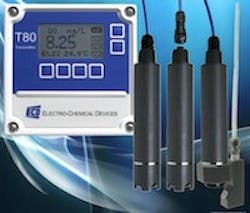Optical Dissolved Oxygen Analyzer Uses Fluorescence Quenching Sensing Element
The Triton DO80 sensor was developed for municipal and industrial wastewater treatment applications. Unlike amperometric sensors, the Triton DO80 has no membranes to replace, no electrolytes to refill and no anode/cathode assemblies to service or replace.
The Triton DO80 now features an ultra long-life membrane cap with no annual replacement required or recommended. Its fluorescence quenching (FQ) sensing element eliminates the need for frequent calibration or membrane replacement. The DO80 interfaces seamlessly with ECD’s new T80 universal transmitter for a cost-saving measurement solution.
The Triton DO80 sensor relies on an FQ method to determine the oxygen concentration of water. It features a circular layer of optically active, oxygen-sensitive molecules integrated into an easily replaceable cap. This durable layer is highly permeable to oxygen and rapidly equilibrates to its surroundings. The cap aligns the optically active fluorescence layer above the two optical components inside the sensor—the emitter and detector.
The Triton DO80 sensor continuously measures the oxygen level and water temperature to calculate dissolved oxygen values. Via digital communication, the DO80 interfaces with the T80 transmitter or ECD’s C-22 controller. The digital signal is nearly immune to common EMI/RFI noise that is typically a problem in many plant environments. The T80 transmitter offers 4-20 mA outputs with MODBUS RTU or HART to communicate with a water treatment plant’s control room while the C22 controller offers 4-20 mA outputs, relays, timers and logic gates for single point control of the aeration process.
Contact Us
Electro-Chemical Devices Inc.
Irvine, CA
800.729.1333
www.ecdi.com
[email protected]
